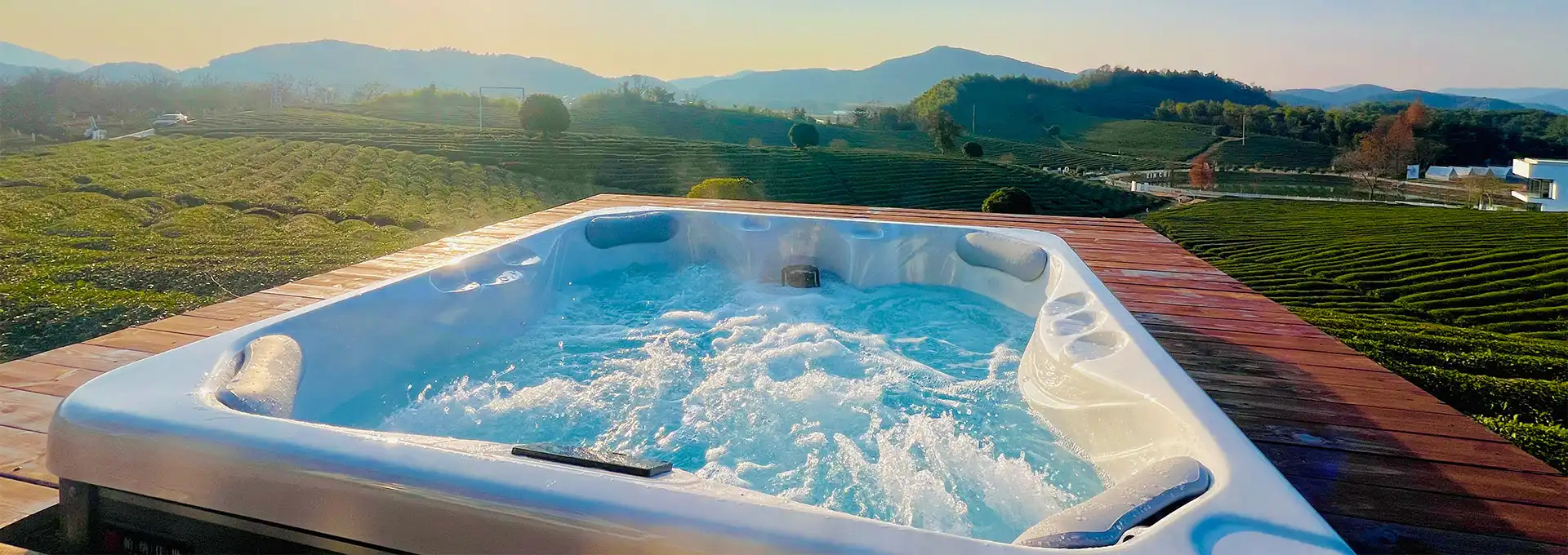How to Regulate Water Level in Swimming Pool Spa?
2024-12-19 16:57:16
Maintaining the proper water level in your swimming pool spa is crucial for its optimal performance, safety, and longevity. A well-regulated water level ensures that your pool's filtration system functions efficiently, prevents damage to equipment, and provides a comfortable swimming experience. In this comprehensive guide, we'll explore the importance of water level regulation and provide practical tips to help you maintain the ideal water level in your swimming pool spa.
What are the ideal water levels for different types of swimming pool spas?
Understanding the ideal water levels for various types of swimming pool spas is essential for proper maintenance and enjoyment. Different pool designs and configurations may require slightly different water levels, but there are general guidelines that apply to most swimming pool spas.
For in-ground pools, the ideal water level is typically about halfway up the skimmer opening. This allows the skimmer to effectively remove debris from the water surface while ensuring that the pump receives an adequate water supply. If the water level is too low, the skimmer may not function properly, and the pump could run dry, potentially causing damage.
Above-ground pools generally require a water level that's about 1/3 to 1/2 way up the skimmer opening. This ensures that the skimmer can operate efficiently without allowing air to enter the system, which could lead to pump issues.
For infinity pools or vanishing edge pools, the water level should be maintained precisely at the edge to create the desired visual effect. These pools often have a catch basin that collects the overflow water and recirculates it back into the main pool.
Hot tubs and spas typically require a water level that covers the highest jets. This ensures that all jets function properly and provide the desired hydrotherapy benefits. It's important to note that the water level in hot tubs may fluctuate more rapidly due to evaporation and user displacement, so more frequent checks may be necessary.
Indoor pool spas often have more stable water levels due to reduced evaporation and environmental factors. However, they still require regular monitoring to maintain the ideal level, which is usually about halfway up the skimmer opening.
It's important to consult your pool manufacturer's guidelines or a professional pool technician to determine the exact ideal water level for your specific swimming pool spa. Factors such as pool design, equipment specifications, and local regulations may influence the recommended water level.
How often should you check and adjust the water level in a swimming pool spa?
Regularly checking and adjusting the water level in your swimming pool spa is a crucial aspect of pool maintenance. The frequency of these checks can vary depending on several factors, including pool usage, weather conditions, and the specific characteristics of your pool.
As a general rule, it's recommended to check your pool's water level at least once a week during the swimming season. However, during periods of heavy use, extreme heat, or after significant rainfall, you may need to check more frequently. In the off-season or for indoor pools, bi-weekly or monthly checks may be sufficient.
Factors that influence water level fluctuations include:
- Evaporation: Hot, dry weather can cause significant water loss through evaporation.
- Splash-out: Active swimmers and pool games can lead to water loss through splashing.
- Backwashing: Regular filter cleaning can remove water from the pool.
- Leaks: Undetected leaks can cause gradual water loss over time.
- Rainfall: Heavy rain can raise the water level in outdoor pools.
To effectively monitor your pool's water level:
- Use a marked skimmer or a dedicated water level indicator as a reference point.
- Check the water level at the same time of day for consistent readings.
- Keep a log of water level measurements to track trends and identify potential issues.
- Consider installing an automatic water level controller for more precise regulation.
When adjusting the water level, add or remove water gradually to avoid over-correction. If you're adding water, use a garden hose or an automatic filling system. If you need to lower the water level, use a submersible pump or your pool's drain system, following local regulations for water disposal.
Remember that maintaining the correct water level is not just about aesthetics; it's crucial for the proper functioning of your pool's circulation and filtration systems. A water level that's too low can cause the pump to run dry and potentially burn out, while a level that's too high can interfere with proper skimming and debris removal.
In addition to regular checks, it's wise to inspect your pool's water level before and after significant events such as heavy rainstorms, pool parties, or extended periods of non-use. This proactive approach can help you address any substantial changes promptly and maintain optimal pool conditions.
What are the best methods for automatically regulating water levels in swimming pool spas?
Automatic water level regulation systems offer a convenient and efficient solution for maintaining the ideal water level in your swimming pool spa. These systems can save time, reduce manual labor, and ensure consistent water levels, even when you're away from home. Here are some of the best methods for automatically regulating water levels in swimming pool spas:
- Float Valve Systems: These simple yet effective systems use a float mechanism similar to those found in toilet tanks. As the water level drops, the float lowers, opening a valve that allows water to flow into the pool. When the water reaches the desired level, the float rises and closes the valve. Float valve systems are relatively inexpensive and easy to install but may require occasional maintenance to ensure proper functioning.
- Electronic Sensor Systems: More advanced than float valves, electronic sensor systems use probes or sensors to detect the water level. When the level drops below a preset point, the system activates a solenoid valve to add water. These systems offer greater precision and can be integrated with smart pool controllers for remote monitoring and control.
- Pressure-Based Systems: These systems use pressure sensors installed in the pool's plumbing to detect changes in water level. As the water level drops, the pressure in the pipes changes, triggering the system to add water. Pressure-based systems are highly accurate and less prone to interference from waves or debris.
- Ultrasonic Level Sensors: Utilizing sound waves to measure the distance between the sensor and the water surface, ultrasonic systems provide non-contact level detection. They're particularly useful in environments where direct contact with the water might be problematic, such as in chemical-heavy or corrosive pool environments.
- Overflow Systems: Common in infinity pools and some high-end pool designs, overflow systems maintain a constant water level by allowing excess water to spill over into a catch basin. The water is then pumped back into the main pool, creating a continuous circulation that maintains a precise water level.
- Smart Pool Controllers: These comprehensive systems integrate water level control with other pool functions such as filtration, heating, and chemical balance. They often include mobile apps that allow remote monitoring and control, providing alerts when water levels need attention.
When selecting an automatic water level regulation system, consider factors such as:
- Pool size and type
- Local climate and evaporation rates
- Desired level of automation and integration with existing pool systems
- Budget constraints
- Ease of installation and maintenance
It's important to note that while automatic systems can greatly simplify pool maintenance, they should not completely replace manual checks and oversight. Regular inspections of the system components and occasional manual verification of water levels are still recommended to ensure optimal performance and catch any potential issues early.
Additionally, when installing an automatic water level regulation system, consider incorporating a water meter or flow sensor to monitor water usage. This can help detect leaks or excessive water consumption, contributing to both water conservation efforts and cost savings.
Lastly, ensure that any automatic system you choose complies with local building codes and pool regulations. Some areas may have specific requirements for pool automation systems, particularly regarding backflow prevention to protect the municipal water supply.
By implementing an appropriate automatic water level regulation system, you can enjoy a consistently well-maintained swimming pool spa with reduced effort and increased peace of mind.
For more information on hot tub installations and to find out more about our products, please feel free to contact us at info@iparnassus.com.
References
- Pool Research. (2021). How to Maintain the Proper Water Level in Your Swimming Pool.
- Swim University. (2022). How to Add or Remove Water from Your Pool.
- Hayward Pool Products. (2023). Automatic Pool Water Levelers.
- PoolSupplyWorld. (2022). Automatic Pool Water Levelers: What You Need to Know.
- APSP (The Association of Pool & Spa Professionals). (2021). ANSI/APSP/ICC-5 2011 American National Standard for Residential Inground Swimming Pools.
- Centers for Disease Control and Prevention. (2022). Healthy Swimming.
- Leslie's Pool Supplies. (2023). How to Maintain Your Pool's Water Level.
- Pentair. (2022). Automatic Water Level Controls.
- Aqua Magazine. (2021). The Importance of Proper Water Level.
- Pool & Spa News. (2022). Automatic Fill Devices: Pros and Cons.
Send Inquiry
Related Industry Knowledge
- How Often Should You Replace Your Hot Tub Filter?
- Is a Swim Spa Considered a Pool?
- Can You Leave a Hot Tub Empty?
- Will Insurance Cover Swim Spa?
- What's a Swim Spa?
- How to Winterize a Swim Spa?
- Can You Go in a Hot Tub with a Sunburn?
- What are the Key Features to Look for in a 5 Person Hot Tub?
- Should I Do Hot Tub or Cold Plunge First?
- How Much Does a Jacuzzi Hot Tub Cost?



